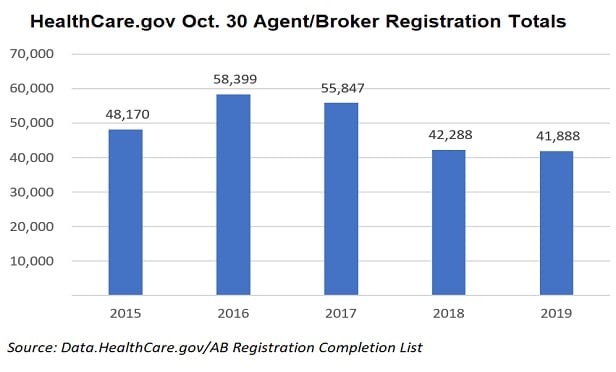 The HealthCare.gov agent/broker count is down just 1 percent from the number reported a year ago. (Chart: Allison Bell/TA)
The HealthCare.gov agent/broker count is down just 1 percent from the number reported a year ago. (Chart: Allison Bell/TA)The sixth annual Affordable Care Act individual major medical open enrollment period groaned out into the daylight, without much love from anyone—but with many agents and brokers.
The Centers for Medicare and Medicaid Services had registered 41,888 agents and brokers to sell 2019 individual major medical plans through the HealthCare.gov system as of Oct. 30.
Related: Americans still pretty confused about the ACA
The HealthCare.gov agent/broker count is down just 1 percent from the number reported a year ago.
Centene Corp., a major ACA public exchange plan issuer, has reported that it will be selling individual coverage in more states in 2019.
HealthSherpa, a health insurance sales support company, says more issuers will be paying sales commissions for 2019 coverage.
On Oct. 19, CMS made an announcement that could have been a sign of major trouble ahead for the ACA public exchange system: The agency said it was shutting down the HealthCare.gov direct enrollment system, a tool for agents and brokers, because of a data breach.
But CMS got the direct enrollment system back online about a week later. Officials at the agency continue to promote a new tool that will funnel HealthCare.gov leads to participating agents.
ACASignups.net, an ACA public exchange tracking blog, is predicting that on-exchange health coverage selection activity will fall about 4.9 percent this year, to about 11.2 million.
One question is what will happen after Tuesday's elections. Depending on what the results are, the Trump administration could resume trying to shut them down, or try to strengthen them and use them as a defense against some Democrats' single-payer health care proposals.
The history
President Barack Obama signed one of the laws that created the ACA, the Patient Protection and Affordable Care Act, March 23, 2010.
He signed the other law in the ACA package, the Health Care and Education Reconciliation Act, March 30, 2010.
Republicans in Congress have been trying to kill the ACA individual major medical market rules, and the ACA public exchange system, ever since. They cut off funding for one major ACA insurer subsidy program, the ACA risk corridors program, early on.
When President Donald Trump entered the White House, he reduced marketing support for the 2017 open enrollment effort immediately, and he ended ACA cost-sharing reduction subsidy payments to insurers 10 months later.
The full list price of individual major medical coverage has skyrocketed.
But Seema Verma, Trump's CMS administrator of the Centers for Medicare and Medicaid Services (CMS), has tried to improve ACA public exchange computer systems and agent support efforts.
The ACA premium tax credit subsidy program has held what most low-income and moderate-income consumers actually pay out-of-pocket for coverage steady.
As a result: Sales to higher-income, full-pay consumers have fallen, but sales to subsidized consumers have increased.
Read more:
© 2025 ALM Global, LLC, All Rights Reserved. Request academic re-use from www.copyright.com. All other uses, submit a request to asset-and-logo-licensing@alm.com. For more information visit Asset & Logo Licensing.







